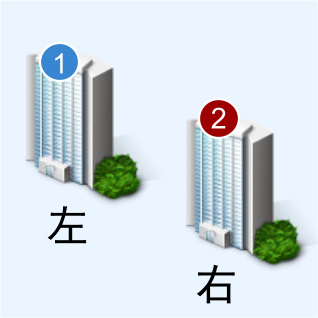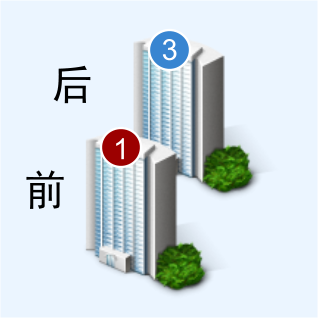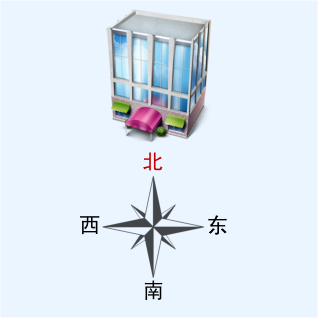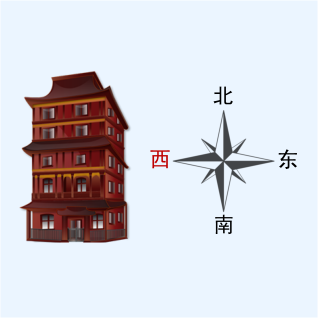
2号楼呢?
‹ 1 hào lóu zài nǎr ?
2 hào lóu ne? ›
In this Chinese audio lesson, we will learn to ask and say where something is located.


Please learn the following Chinese vocabulary by saying the words and writing the new characters several times.
| Word | Pinyin | Translation | ||
| 1 | 在 | zài | to be located, to be | |
| 2 | 这儿 | zhèr | here | |
| 3 | 那 | nà | that | |
| 4 | 哪儿 | nǎr | where | |
| 5 | 边 | bian | (locative suffix which can be translated as "direction" or "side ...") | |
| 6 | 东 | dōng | east | |
| 7 | 南 | nán | south | |
| 8 | 西 | xī | west | |
| 9 | 北 | běi | north | |
| 10 | 右 | yòu | right | |
| 11 | 左 | zuǒ | left | |
| 12 | 前 | qián | in front, forward | |
| 13 | 后 | hòu | behind; back | |
| 14 | 旁 | páng | side | |
| 15 | 地方 | dìfāng | place | |
| 16 | 厕所 | cèsuǒ | toilets | |
| 17 | 银行 | yínháng | bank | |
| 18 | 学校 | xuéxiào | school | |
| 19 | 书店 | shūdiàn | bookstore | |
| 20 | 餐馆 | cānguǎn | restaurant | |
| 21 | 不客气 | bùkèqì | welcome | |
| 22 | 楼 | lóu | building | |
| 23 | 对 | duì | exact; right | |
| 24 | 它 | tā | it | |
| 25 | 大 | dà | big (but particularly for surface / area or age); large; wide | |
| 26 | 什么 | shénme | what |
| Word | Pinyin | Translation | ||
| 1 | 家 | jiā | (classifier for all kind of establishment) | |
| 2 | 座 | zuò | (classifier for large building in the mountain) |

In Chinese, to express the position of someone or something, we use the verb "在 ‹ zài ›".
When an adverb of place is used as the object, it is placed after this verb.
To ask the question "Where is ...", here is the standard sentence structure:
When an adverb of place is used as an attribute, the possessive particle 的 ‹ de › is optional.
First read to the texts several times until they are well understood before reading their translation.
- 请问,厕所在这儿吗?‹ Qǐngwèn, cèsuǒ zài zhèr ma? ›
- 对,在这儿。 ‹ Duì, zài zhèr. ›
- 谢谢。 ‹ Xièxie. ›
- 不用谢。 ‹ Bùyòng xiè. ›
- 请问,这是什么地方? ‹ Qǐngwèn, zhè shì shénme dìfāng? ›
- 这是书店。‹ Zhè shì shūdiàn. ›
- 银行在哪儿?‹ Yínháng zài nǎr ? ›
- 后边的那座楼是银行。 ‹ Hòumian de nà zuò lóu shì yínháng. ›
- 谢谢!‹ Xièxie! ›
- 不客气!‹ Bù kèqì! ›
Translation :
- Please, what is this place?
- This is the bookstore.
- Where is the bank?
- The bank is behind that building.
- Thank you!
- You're welcome!


这是我们的学校。它很大。 这是我们上课的地方。 1号楼,2号楼在前边。 3号楼,4号楼在后边。 4号楼的后边有一家书店。
‹ Zhè shì wǒmen de xuéxiào. Tā hěn dà. Zhè shì wǒmen shàngkè de dìfāng. 1 hào lóu,2 hào lóu zài qiánbian. 3 hào lóu,4 hào lóu zài hòubian. 4 hào lóu de hòubian yǒu yī jiā shūdiàn. ›
Translation :
This is our school. It is big. This is where the classes are held. The building No. 1 and the building No. 2 are in front. The building No. 3 and the building No. 4 are behind. Behind the building No. 4 there is a bookstore.





(1) Ex : 1号楼在2号楼的左边。‹ 1 hào lóu zài 2 hào lóu de zuǒbiān. ›
1. The toilet is (located) on your left.
2. This person next to you.
3. This building in front of the bank.
4. The restaurant south of the bookstore.
